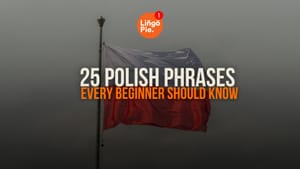You've been diligently learningPolish through grammar exercises, memorizing vocabulary lists, and practicing pronunciation. But when it comes time to actually speak with Polish people, something feels... off. Your carefully constructed sentences sound stiff, textbook-like, almost robotic compared to the natural flow you hear from native speakers.
If this sounds familiar, you're not alone. This is the most common challenge facing Polish learners today—the gap between academic Polish and the way people actually communicate in Warsaw cafes, Krakow offices, and Polish family dinners.
In this article, we’ll break down simple, effective ways to level up your Polish speaking skills—so you can chat, joke, and connect like a local, not a language app.
- Is Polish Hard To Learn?
- 20+ Polish Slang Words You Need In Your Life
- How To Use Lingopie: Step-by-Step Guide For Beginners

How to Improve Your Polish Conversation Skills

Rather than guessing at solutions, we decided to dig deeper into what makes Polish conversation sound natural versus textbook-like. Over the past few months, we analyzed conversation patterns from 40+ hours of authentic Polish dialogue—including TV shows, podcasts, and everyday interactions.
We also reviewed common feedback patterns from Polish language learners and consulted linguistic research on conversational Polish.
What we learned is that there are five specific areas where textbook Polish creates an unnatural "learning accent" that immediately signals to native speakers that you're still thinking in translation mode rather than authentic Polish communication patterns.
The good news? These patterns are completely fixable once you know what to look for.
Replace Formal Greetings with Contextual Ones
Most Polish textbooks teach you to greet everyone with "Dzień dobry" (Good day) or ask "Jak się masz?" (How are you?) as standard conversation starters. While grammatically correct, this approach makes you sound like you're reading from a phrasebook.
Polish greeting culture is more nuanced than English. Unlike English speakers who casually ask "How are you?" as a greeting ritual, Poles interpret "Jak się masz?" as a genuine inquiry about your wellbeing—which can feel invasive coming from someone they've just met.
| Textbook Polish | Natural Polish | When to Use |
|---|---|---|
| Dzień dobry. Jak się masz? | Cześć! Co słychać? | Casual settings with friends |
| Jak się Pan/Pani ma? | Dzień dobry! Miło Pana/Panią widzieć | Formal settings, showing respect |
| Jak się czujesz? | No, jak tam? | Close friends, checking in casually |
In Polish conversation, greetings match the relationship and setting much more precisely than in English, where "How are you?" works universally.
Use Natural Conversation Fillers (Not Academic Transitions)
Polish learners often rely on formal transitional phrases learned from grammar books, creating speech that sounds like a university presentation rather than casual conversation. However, you must understand that academic Polish uses different connecting words than conversational Polish.
Textbooks emphasize precision and formality, while real conversations flow with natural hesitations, informal bridges, and cultural references that create connection.
| Textbook Polish | Natural Polish | When to Use |
|---|---|---|
| Następnie chciałbym powiedzieć... | No i wtedy... | Continuing a story naturally |
| W związku z tym... | No więc... | Drawing conclusions casually |
| Jednakże należy zauważyć... | Ale wiesz co... | Introducing a contrasting point |
"No" is incredibly versatile in Polish conversation—it's not always "no" but rather a way to keep conversation flowing. One tip is to try adding 'no' or 'no więc' to make your speech sound connected and natural, like you're thinking in Polish rather than translating.
Master Authentic Reaction Words (Beyond "Tak/Nie")
Polish conversation is highly expressive, but textbooks typically teach only basic "tak" (yes) and "nie" (no) responses. This makes learners sound emotionally flat and disengaged, missing the reactions that make Polish conversation so dynamic.
Polish speakers use an extensive range of reaction words to show engagement, surprise, agreement, or disbelief. These words carry emotional weight and cultural nuance that simple yes/no answers can’t convey.
| Textbook Polish | Natural Polish | When to Use |
|---|---|---|
| Tak, to prawda | No jasne! | Enthusiastic agreement |
| Nie, to nieprawda | Ale co ty! | Surprised disbelief |
| To jest interesujące | O wow! / Łał! | Expressing genuine surprise |
Polish conversation values showing you're emotionally present and engaged—flat responses suggest you're not really listening or connecting.
Learn Colloquial Question Patterns (Not Textbook Interrogatives)
Academic Polish teaches formal question structures that, while correct, make everyday conversations feel like job interviews. Real Polish questions often use different word orders, casual contractions, and informal patterns.
Remember, conversational Polish frequently drops formal elements, rearranges standard word order for emphasis, and uses context to carry meaning rather than explicit grammatical structures.
| Textbook Polish | Natural Polish | When to Use |
|---|---|---|
| Czy mógłby Pan mi powiedzieć...? | Możesz mi powiedzieć...? | Casual requests for information |
| Gdzie Pan mieszka? | Gdzie mieszkasz? | Getting to know someone informally |
| Co Pan myśli o tym? | Co myślisz? / Jak myślisz? | Asking for opinions among peers |
The formal "Pan/Pani" system matters in Polish, but overusing it creates unnecessary distance in casual interactions where warmth and connection are more important.
Embrace Polish Cultural Speech Patterns
Polish conversation includes cultural patterns that textbooks rarely teach—specific ways of showing politeness, handling disagreement, or expressing uncertainty that reflect Polish social values.
These patterns develop naturally in native speakers through social interaction and cultural immersion. They're not actual grammar rules but social conventions that signal cultural fluency and genuine connection.They’re
| Textbook Polish | Natural Polish | When to Use |
|---|---|---|
| Nie zgadzam się | Hm, nie jestem pewien/pewna... | Gentle disagreement without confrontation |
| Nie wiem | No nie wiem, może... | Showing thoughtful consideration |
| To jest trudne | Ale to niezły challenge! | Acknowledging difficulty positively |
Polish communication often softens direct statements to maintain harmony and show respect for others' perspectives—this isn't being indirect, it's being culturally appropriate.
Example Polish Conversation
Let's see these tips in action. Here's how the same conversation sounds using textbook Polish versus natural Polish patterns:
Textbook Version (Robotic)
Kasia: Dzień dobry. Jak się masz?
Mark: Dzień dobry. Mam się dobrze, dziękuję. Jak się Pani ma?
Kasia: Także dobrze, dziękuję. Czy mógłby Pan mi powiedzieć, co Pan myśli o tym filmie?
Mark: Tak, uważam, że ten film jest interesujący. Jednakże należy zauważyć, że fabuła jest skomplikowana.
Kasia: Nie zgadzam się. Myślę, że jest łatwy do zrozumienia.
Natural Version (Conversational)
Kasia: Cześć! Co słychać?
Mark: No, wszystko w porządku. A u ciebie jak?
Kasia: Spoko, dzięki. Słuchaj, co myślisz o tym filmie?
Mark: O wow, no nie wiem... było ciekawe, ale trochę pokręcone, nie?
Kasia: Ale co ty! Mnie się wydawało całkiem jasne.
What Changed
- Greeting: "Cześć! Co słychać?" instead of formal "Dzień dobry. Jak się masz?"
- Natural fillers: "No," "Słuchaj," and "nie?" create conversational flow
- Authentic reactions: "O wow" and "Ale co ty!" show genuine engagement
- Casual transitions: "A u ciebie jak?" instead of formal repetition
- Cultural softening: "no nie wiem... nie?" shows thoughtful uncertainty rather than blunt statements
The natural version uses 40% fewer words but feels more connected and engaging. Polish conversation values emotional connection over formal precision.
How to Practice These Tips Effectively
1. Media Immersion
The best way to internalize these natural patterns is through authentic Polish media. With Lingopie's upcoming Polish launch, you'll have access to real Polish TV shows and movies with interactive subtitles. Watch for these natural conversation patterns and note how they differ from textbook Polish.
2. Practice with Context, Not Lists
Rather than memorizing isolated phrases, practice these expressions within full conversations. Record yourself having imaginary discussions using these natural patterns, then listen back to hear how they flow.
3. Find Language Exchange Partners
Connect with Polish speakers through language exchange platforms. Specifically ask them to point out when your speech sounds "textbook-like" and request more natural alternatives.
4. Focus on One Tip Per Week
Trying to implement all five tips simultaneously will overwhelm you. Pick one area (like natural greetings) and focus exclusively on that for a week before moving to the next.
5. Welcome Mistakes
Native speakers will appreciate your effort to sound more natural, even if you occasionally get it wrong. Most Poles are delighted when foreigners attempt cultural speech patterns rather than sticking to formal textbook Polish.
Ready To Learn Polish?
Remember, developing natural conversation skills takes time. Be patient with yourself as you transition from textbook Polish to the expressive way Poles actually speak. With consistent practice using authentic media and real conversation opportunities, you'll find yourself moving from robotic responses to genuine, culturally fluent Polish conversation.
If you're genuinely interested to learn, sign up for a FREE 7-day trial with Lingopie to get started! From the inside, you'll be the first to see and experience how Polish TV can help improve your skills. Give it a try now!


![How to Improve Your Polish Conversation Skills [5 Best Tips]](/blog/content/images/size/w1200/2025/06/improve-polish-conversation-skills.jpg)





![5 Best Apps To Learn Polish As A Beginner [2025]](/blog/content/images/size/w300/2025/08/best-apps-to-Learn-Polish.jpg)
![What’s The Best Way To Learn Polish Quickly? [Guide]](/blog/content/images/size/w300/2025/08/What-s-The-Best-Way-To-Learn-Polish-Quickly.jpg)